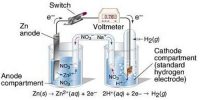If the equilibrium constant for a reaction is given, it is possible to calculate the concentrations of substances in the equilibrium concentrations or mixture.
Consider the following equilibrium:
CO (g) + 3H2 (g) = CH2 (g) + H2O (g)
A gaseous mixture at equilibrium contains 0.30 mol of CO, 0.10 mol of H2, 0.020 mol of H2O and an unknown amount of CH4 in a 1.0 dm3 container. What is the concentration of CH4 in this mixture if the equilibrium constant Kc equals 3.92 mol-2 dm6?
First, calculate concentrations from moles of substances.
- [CO] = 0.30 mol / 1.0 dm3 = 0.30 mol.dm-3
- [H2] = 0.10 mol / 1.0 dm3= 0.10 mol.dm-3
- [H2O] = 0.02 mol / 1.0 dm3 = 0.02 mol.dm-3
The equilibrium constant Kc for this equation is given’ as
Kc = {[CH4 x [H2O]) / {[CO] x [H2]3)
Substituting the known concentrations and the value of Kc gives
3.92 = ([CH4] x 0.02) / (0.3 x 0.023) [CH4] = 0.059 moLdm-3
The concentration of CH4 in the mixture is equal to 0.059 mol.dm-3.
Suppose we begin a reaction with known amounts of starting materials and want to calculate the quantities at equilibrium.
Use the stoichiometry of the equation to work out how the number of moles of reactants will change. Then convert the moles to concentration before putting into the Kc expression.













